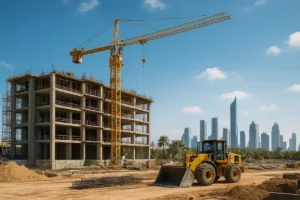Risk Management in Saudi Construction
Risk management in Saudi Arabia’s construction industry is more vital than ever. With the rapid pace of development under Saudi Vision 2030, the construction sector in Saudi Arabia is growing quickly, but it faces significant hurdles. Effective risk management — covering everything from the supply chain of materials to weather-related delays — is key to project success. In this article, we’ll explore the concept of risk management in Saudi Arabia construction, examine supply chain issues, weather-delay risks, strategies to mitigate them, and practical examples.
What is Risk Management in Construction in Saudi Arabia?
Definition and Context
Risk management in construction refers to the systematic identification, analysis, mitigation, and monitoring of potential issues that may affect project cost, schedule, quality, or safety. In the context of Saudi Arabia construction, this means adapting to local conditions: regulatory frameworks, climate extremes, labour market dynamics, supply chain dependencies, and the scale of mega-projects underway.
Why It Matters in Saudi Arabia
-
The construction sector in Saudi Arabia is among the fastest growing in the Gulf region, thanks to infrastructure investment and large-scale developments.
-
Delays and cost overruns are common: a review of Saudi Arabia construction delay studies found hundreds of contributing factors.
-
Supply chain vulnerabilities and weather/climate risks are increasingly critical for Saudi Arabia construction projects, given the region’s environment and import dependencies.
Key Types of Risks in Saudi Arabia Construction
Some of the most important risk categories for construction in Saudi Arabia include:
-
Supply-chain risks: material availability, import delays, logistics.
-
Contractual/financial risks: delayed payments, scope changes, design changes.
-
Weather & environmental risks: extreme heat, sandstorms, occasional heavy rain/flooding.
-
Labour & productivity risks: skill shortages, local-labour policies, productivity drops.
By understanding these in the Saudi Arabia construction context, project leaders can build effective risk-management frameworks.
Supply Chain Risk Management in Saudi Arabia Construction
What Supply Chain Risks Look Like in Saudi Arabia Construction
For construction projects in Saudi Arabia, supply chain risks typically involve the following:
-
Delays in delivery of key materials, components or equipment imported or sourced abroad. For example, a recent review of supply chain operations in Saudi Arabia construction identified raw material price escalation, labour crisis, taxation changes and logistical challenges.
-
Price inflation and volatility of construction materials. A study found material delivery delays and price escalation among the top risk factors in Saudi Arabia construction delays.
-
Logistics, warehousing and transportation interruptions. Globally, a 2023 report found that logistics and warehousing shortages impacted supply chain risks in construction at ~34% of respondents.
-
Labour/visa/regulation changes impacting supply chain indirectly (such as changing supplier base due to visa/tax changes) in Saudi Arabia.
Why These Risks Are Significant in Saudi Arabia Construction
-
The reliance on imported materials and equipment increases vulnerability to global disruptions and trade logistics.
-
The desert climate and location mean that delays or shortages have amplified impacts on schedule and cost.
-
Regulatory and labour-market dynamics in Saudi Arabia (such as Saudi-isation policies, visa/expat labour) add another layer of complexity in the construction supply chain.
-
The scale of mega-projects (e.g., new cities, infrastructure) in Saudi Arabia means even small supply chain disruptions ripple widely.
Strategies to Mitigate Supply Chain Risks in Saudi Arabia Construction
Here are practical measures for construction risk management in Saudi Arabia:
-
Diversify the supplier base: Both local and international sources to avoid single-point failures.
-
Early procurement and long-lead planning: Identify critical materials/equipment early and place orders ahead of schedule.
-
Buffer stocks and local warehousing: Especially for key materials to reduce lead-time risk.
-
Contract clauses & risk allocation: Include supply-chain risk clauses in contracts with suppliers/contractors to clarify responsibilities.
-
Monitor price trends and inflation: Forecast cost escalation for materials and include contingency budgets.
-
Use digital supply-chain tools: Real-time tracking of logistics flows, KPIs for delivery, visibility of potential bottlenecks.
-
Local manufacturing and sourcing: Where possible, shift to local or regional manufacturing to reduce import dependence.
By applying these strategies, construction projects in Saudi Arabia can strengthen resilience in their supply-chains and reduce schedule/cost risks.
Weather and Environmental Delays in Saudi Arabia Construction
The Nature of Weather Risks in Saudi Arabia Construction
The climate and environment in Saudi Arabia bring specific challenges for construction:
-
Extreme heat: In many regions, summer daytime temperatures exceed 45 °C, which reduces worker productivity and increases risk of heat-related illnesses.
-
Sandstorms and high winds: These can halt outdoor work, reduce visibility, damage equipment, and create safety risks.
-
Occasional heavy rainfall/flooding: Though rainfall is infrequent, when it occurs in desert regions it often leads to flash flooding and site disruption.
-
Environmental regulation and health & safety: Worker safety under harsh ambient conditions is both a risk and regulatory requirement in Saudi Arabia construction.
Impact on Saudi Arabia Construction Projects
-
Productivity losses: High heat slows down worker output, increases breaks and downtime. One Saudi Arabia-specific article notes that extreme heat causes equipment efficiency issues and worker fatigue.
-
Cost overruns & schedule delays: Weather-related disruptions have been estimated to increase costs by up to 20 % in some scenarios.
-
Safety and legal risk increase: Worker illness/injury from heat or storms can cause liability and halt work.
-
Planning uncertainty: When weather events are not properly accounted for in schedule risk models, delays compound.
Mitigation Strategies for Weather-Related Risk in Saudi Arabia Construction
-
Schedule work to avoid peak heat: Shift outdoor work to cooler hours (early morning, evening) during hot months.
-
Adopt weather-sensitive planning: Integrate historical climate data for the region into planning, allow buffer days for weather stoppages.
-
Provide worker protection and monitoring: Shade, cooling zones, hydration stations, real-time temperature monitoring.
-
Use appropriate materials and technologies: Materials that withstand high temperatures/sand exposure; equipment designed for desert conditions.
-
Develop contingency plans for sandstorms/flooding: Preparedness to pause work, secure sheds, protect equipment, and resume quickly.
-
Training & safety protocols: Educate workforce on heat-stress, sandstorm safety, and emergency procedures.
By incorporating weather risk management into the broader risk management framework, Saudi Arabia construction projects can be more resilient to climate-related disruptions.
Pros & Cons of Strong Risk Management in Saudi Arabia Construction
Pros:
-
Higher probability of on-time, on-budget completion in a challenging environment.
-
Better stakeholder confidence (owners, contractors, investors) when risks are proactively managed.
-
Improved worker safety and productivity during extreme conditions.
-
Reduced litigation or claims related to delay or contract breaches.
Cons / Challenges:
-
Up-front cost and effort: developing supply-chain buffers, weather-resilient schedules, risk monitoring systems adds cost and planning time.
-
Uncertainty remains: some risks (e.g., extreme sandstorms, global supply disruptions) cannot be fully eliminated—only mitigated.
-
Complexity in contract allocation: assigning responsibility for weather or supply delays can lead to dispute if not clearly documented.
-
In Saudi Arabia’s fast-paced construction environment, pressure to deliver may lead to risk shortcuts or under-estimating weather/supply risks.
Conclusion
Risk management in construction in Saudi Arabia is essential to navigate both supply-chain vulnerabilities and weather-related delays. With the sector’s growth under Saudi Vision 2030, project stakeholders must build robust risk frameworks that cover: supplier reliability and logistics, climate-sensitive planning, labour productivity under extreme conditions, and contract/risk-allocation clarity. By identifying risks early, analysing their impact, preparing mitigation strategies, and monitoring performance, construction projects in Saudi Arabia can significantly improve their chances of success. From material procurement to sandstorms and heat waves, a comprehensive risk-management approach helps safeguard timelines, budgets and quality.
Whether you’re a contractor, project manager or owner in the Saudi Arabia construction sector, implementing these practices will strengthen resilience and performance. Explore further, adopt best practices and tailor your risk-management system to the unique Saudi environment.



